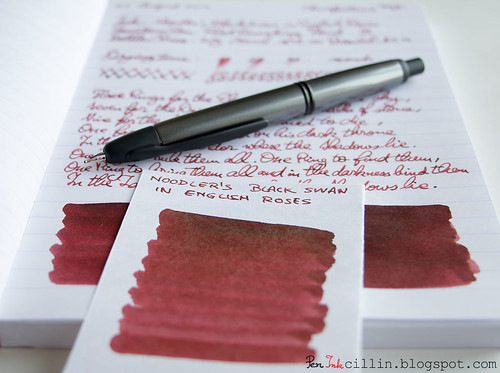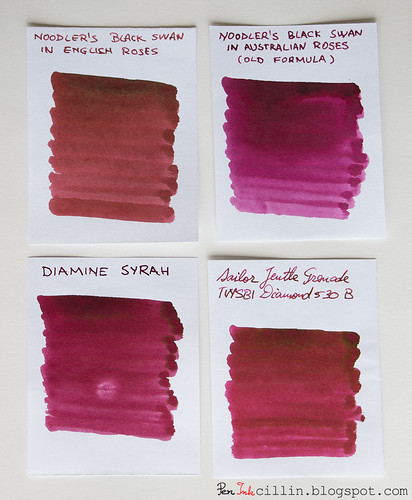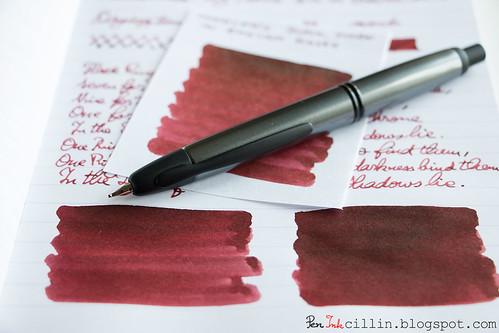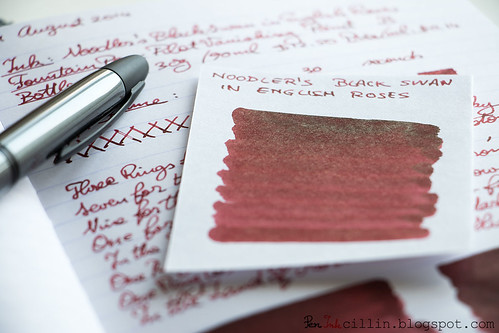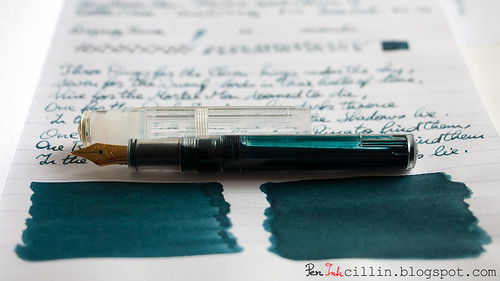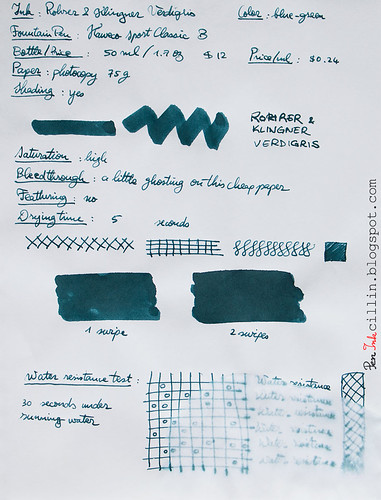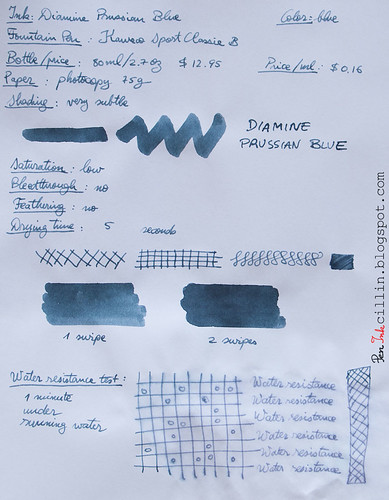I know, I know, I promised that my next review would be from my collection of ink samples, based on the ink sample survey I ran a few weeks ago. I'm afraid I'm going to have to disappoint those who were expecting this, at least for another week. If you don't care why, skip the next paragraph.
There's a rhyme and reason as to what fountain pens I use for my reviews. Lately, I've come to prefer the Kaweco Sport Classic for ink samples, for several reasons. First, it has a broad nib, which shows off the ink better but more importantly allows me to go through inks quicker. Second, it's a relatively inexpensive pen which I can use at work without fear of losing/breaking a nicer pen. Third, I use it as an eyedropper, which means that I can load it with the full 2ml from an ink sample. This allows me to exhaust a complete sample for each review. Well, today's review, Diamine Green Black, came in a bottle. Since my Lamy AL-Star was clean, I decided to load it up and do a quick review before I can finish the Waterman Blue in my Kaweco.
Today's ink, Diamine Green Black, comes courtesy of Jetpens. A while ago I tweeted this:
I just have this thing for British Racing Green, the color. So Jetpens suggested Diamine Green Black and were nice enough to send me a bottle for review. As soon as my Lamy AL-Star (with EF nib) was clean and dry, I loaded it up with Diamine Green Black and... let's see how well it performs.
Before we start, you might want to follow me on Twitter: @Peninkcillin.
Bottle and pricing
My main beef with Diamine inks is that their box and bottle design is very plain and boring. Not only that but it's very hard to tell at a glance what ink is inside. No custom design, not even a color patch. Only a tiny sticker that weakly whispers the name of the ink. Even Noodler's bottles are cooler because all of them have custom graphics. That's such a shame because Diamine makes such great inks. Oh well, I'd rather have a great ink in a boring bottle than a lousy ink in a gorgeous package.
Diamine inks come in an 80ml / 2.7oz bottle and cost around $12.95 or $0.16 per milliliter, among the least expensive.
Color and saturation
Ah, now we're getting to the heart of the matter. The big question is: how closely does Diamine Green Black resemble the color British Racing Green? To my eyes, I would say a lot. I'm perfectly satisfied with this color. In fact, even if it was very far from BRG, I would still love it. I'll be honest: this is the best shade of green I've tested.
However, I decided to run a very non-scientific test to see just how similar the two colors are. So I did this little trick in Photoshop:
I took the standard British Racing Green swatch and placed it between averaged (via blur) samples of Diamine Green Black. The first sample is 1 swipe with a q-tip while the second is 2 swipes. As you can see, BRG is actually lighter than both samples. Don't read too much into this though. For starters, consider that my samples are photographed and processed, which tends to alter the colors, while the BRG swatch is pure. Besides, the thickness of the ink sample can alter the averaged value considerably. Let's just leave it at that.
Color aside, you will notice that Diamine Green Black is a dark, saturated ink. The Green Black name is very appropriate. I feel that it can be successfully used in a professional setting. It looks even darker on glossy paper because more of it has the chance to pool on the surface before being absorbed.
Shading
Diamine Green Black doesn't disappoint and it features some decent amount of shading. The choice of paper will make a difference though, and this will come into play soon, as you will see. In other words, the shading is more visible on good paper and less so on cheap one.
Feathering
I was a bit surprised to notice that Diamine Green Black feathers a little on the cheap photocopy paper that I used for one of my test samples. It's not a lot but it's there. No such thing happens on Rhodia 80g. But then, not everybody uses their fountain pens on some of the cheapest paper available, so take that with a grain of sand.
Bleedthrough
Another small weakness, but wholly expected considering the poor quality of the paper and the darkness of the ink, is that it bleeds on cheap paper. You can still write on the reverse if you are using it as scrap but I would advise to try it before using it in any official document where bleeding might be an issue. Again, there's no bleeding on thicker/better paper such as Rhodia.
Flow, lubrication, and smoothness
In regards to flow and smoothness, things are looking very good. Diamine Green Black all but purrs when it flows through my Lamy AL-Star. It feels well lubricated, too. I would give it a 7-8 out of 10 for wetness. This also means that it dries differently, depending on the paper.
Drying time
Wet inks tend to dry quickly on poor, absorbent paper, and very slowly on glossy, high quality paper like the Rhodia 80g I used for one of the samples. On photocopy it dries within 5 seconds, while on Rhodia it takes its sweet time, at 20+ seconds.
Smearing when dry
None.
Water resistance
There isn't any water resistance to speak of, but perhaps contact with water wouldn't be a total disaster considering that some yellow undertones remained on the paper after the main green color washed off.
Conclusion
Diamine Green Black has been a very pleasant surprise for me. Not only does it resemble British Racing Green to some extent, but it is very smooth and wet flowing, with some solid shading. The two negatives, namely bleeding and a little feathering, aren't a big deal and they would be completely moot for those who prefer high quality paper anyway. Diamine Green Black is a beautiful ink. If you like dark green inks, do yourself a favor and try it. I doubt you'll be disappointed.
Following are the two samples, on photocopy and Rhodia 80g, respectively.
There's a rhyme and reason as to what fountain pens I use for my reviews. Lately, I've come to prefer the Kaweco Sport Classic for ink samples, for several reasons. First, it has a broad nib, which shows off the ink better but more importantly allows me to go through inks quicker. Second, it's a relatively inexpensive pen which I can use at work without fear of losing/breaking a nicer pen. Third, I use it as an eyedropper, which means that I can load it with the full 2ml from an ink sample. This allows me to exhaust a complete sample for each review. Well, today's review, Diamine Green Black, came in a bottle. Since my Lamy AL-Star was clean, I decided to load it up and do a quick review before I can finish the Waterman Blue in my Kaweco.
Today's ink, Diamine Green Black, comes courtesy of Jetpens. A while ago I tweeted this:
Anyone know which ink best resembles British Racing Green? pic.twitter.com/kiq3y3AWDy— Peninkcillin (@Peninkcillin) April 8, 2014Before we start, you might want to follow me on Twitter: @Peninkcillin.
Bottle and pricing
My main beef with Diamine inks is that their box and bottle design is very plain and boring. Not only that but it's very hard to tell at a glance what ink is inside. No custom design, not even a color patch. Only a tiny sticker that weakly whispers the name of the ink. Even Noodler's bottles are cooler because all of them have custom graphics. That's such a shame because Diamine makes such great inks. Oh well, I'd rather have a great ink in a boring bottle than a lousy ink in a gorgeous package.
Diamine inks come in an 80ml / 2.7oz bottle and cost around $12.95 or $0.16 per milliliter, among the least expensive.
Color and saturation
Ah, now we're getting to the heart of the matter. The big question is: how closely does Diamine Green Black resemble the color British Racing Green? To my eyes, I would say a lot. I'm perfectly satisfied with this color. In fact, even if it was very far from BRG, I would still love it. I'll be honest: this is the best shade of green I've tested.
However, I decided to run a very non-scientific test to see just how similar the two colors are. So I did this little trick in Photoshop:
I took the standard British Racing Green swatch and placed it between averaged (via blur) samples of Diamine Green Black. The first sample is 1 swipe with a q-tip while the second is 2 swipes. As you can see, BRG is actually lighter than both samples. Don't read too much into this though. For starters, consider that my samples are photographed and processed, which tends to alter the colors, while the BRG swatch is pure. Besides, the thickness of the ink sample can alter the averaged value considerably. Let's just leave it at that.
Color aside, you will notice that Diamine Green Black is a dark, saturated ink. The Green Black name is very appropriate. I feel that it can be successfully used in a professional setting. It looks even darker on glossy paper because more of it has the chance to pool on the surface before being absorbed.
Shading
Diamine Green Black doesn't disappoint and it features some decent amount of shading. The choice of paper will make a difference though, and this will come into play soon, as you will see. In other words, the shading is more visible on good paper and less so on cheap one.
Feathering
I was a bit surprised to notice that Diamine Green Black feathers a little on the cheap photocopy paper that I used for one of my test samples. It's not a lot but it's there. No such thing happens on Rhodia 80g. But then, not everybody uses their fountain pens on some of the cheapest paper available, so take that with a grain of sand.
Bleedthrough
Another small weakness, but wholly expected considering the poor quality of the paper and the darkness of the ink, is that it bleeds on cheap paper. You can still write on the reverse if you are using it as scrap but I would advise to try it before using it in any official document where bleeding might be an issue. Again, there's no bleeding on thicker/better paper such as Rhodia.
Flow, lubrication, and smoothness
In regards to flow and smoothness, things are looking very good. Diamine Green Black all but purrs when it flows through my Lamy AL-Star. It feels well lubricated, too. I would give it a 7-8 out of 10 for wetness. This also means that it dries differently, depending on the paper.
Drying time
Wet inks tend to dry quickly on poor, absorbent paper, and very slowly on glossy, high quality paper like the Rhodia 80g I used for one of the samples. On photocopy it dries within 5 seconds, while on Rhodia it takes its sweet time, at 20+ seconds.
Smearing when dry
None.
Water resistance
There isn't any water resistance to speak of, but perhaps contact with water wouldn't be a total disaster considering that some yellow undertones remained on the paper after the main green color washed off.
Conclusion
Diamine Green Black has been a very pleasant surprise for me. Not only does it resemble British Racing Green to some extent, but it is very smooth and wet flowing, with some solid shading. The two negatives, namely bleeding and a little feathering, aren't a big deal and they would be completely moot for those who prefer high quality paper anyway. Diamine Green Black is a beautiful ink. If you like dark green inks, do yourself a favor and try it. I doubt you'll be disappointed.
Following are the two samples, on photocopy and Rhodia 80g, respectively.














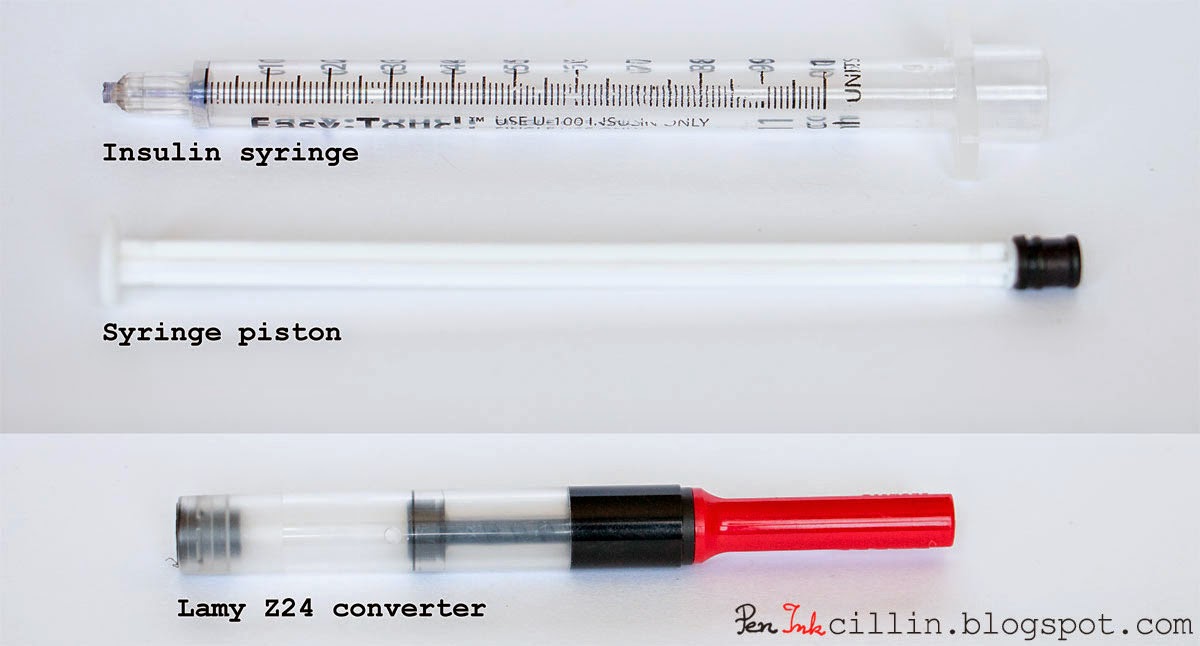















 . It won't cost you any extra but I will get a few pennies from the sale.
. It won't cost you any extra but I will get a few pennies from the sale.




































































